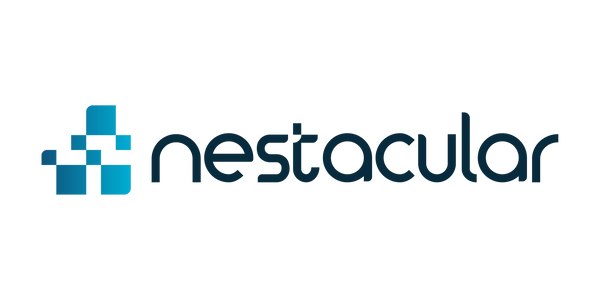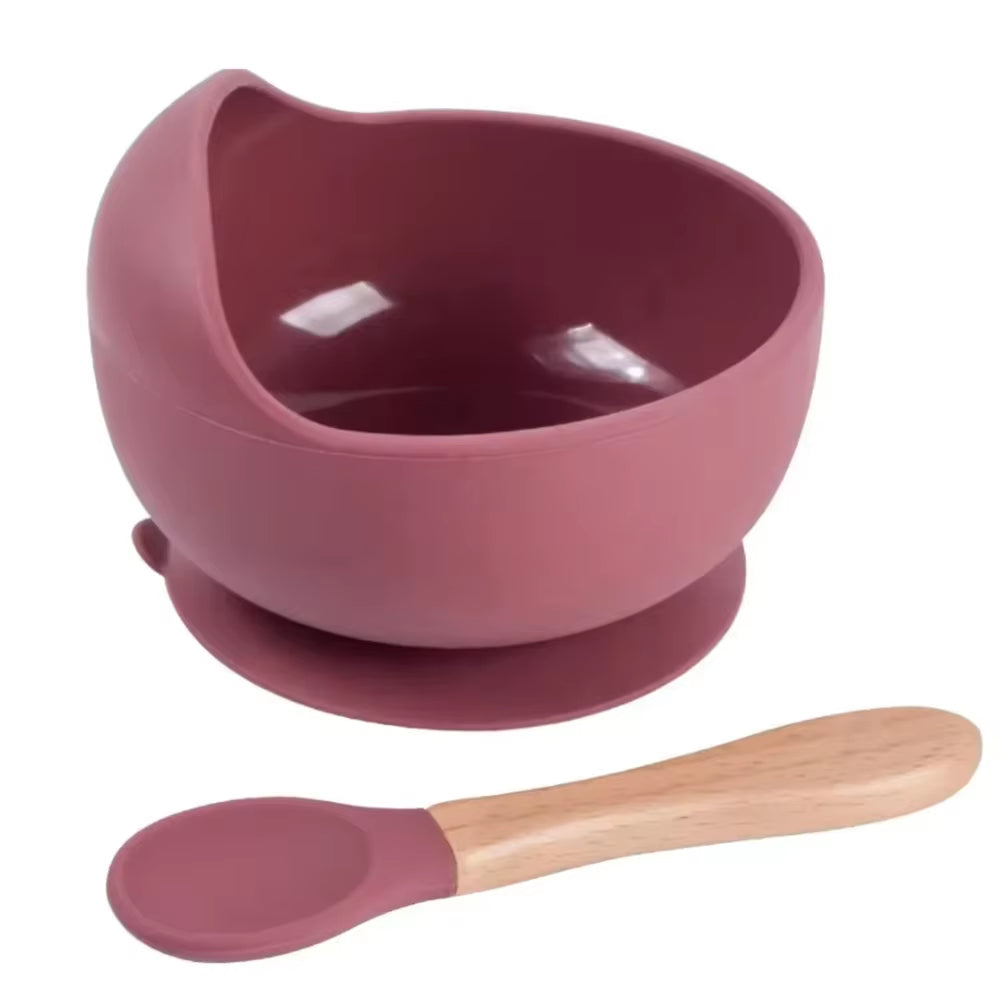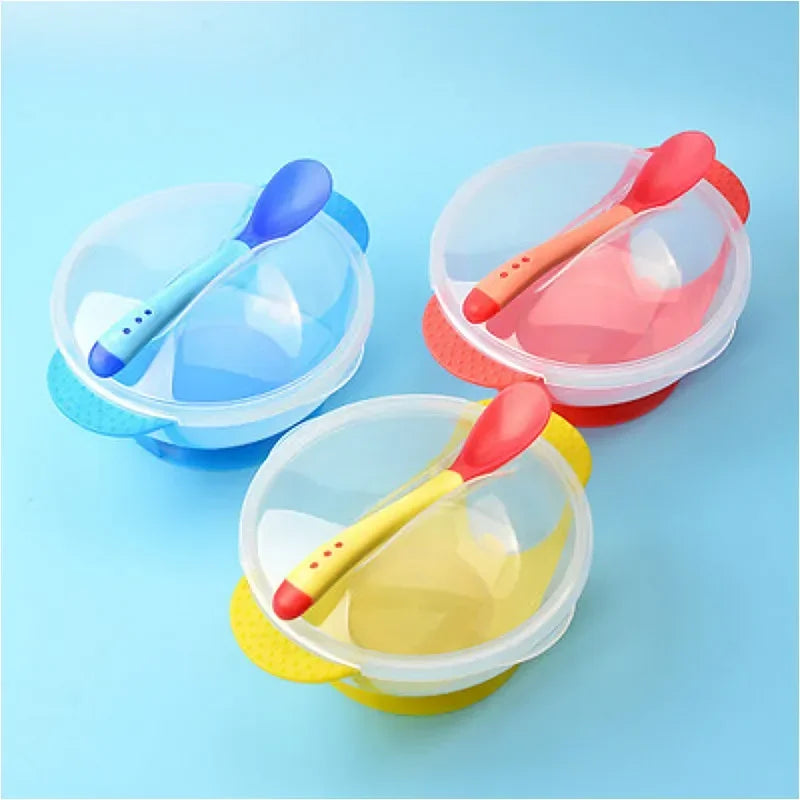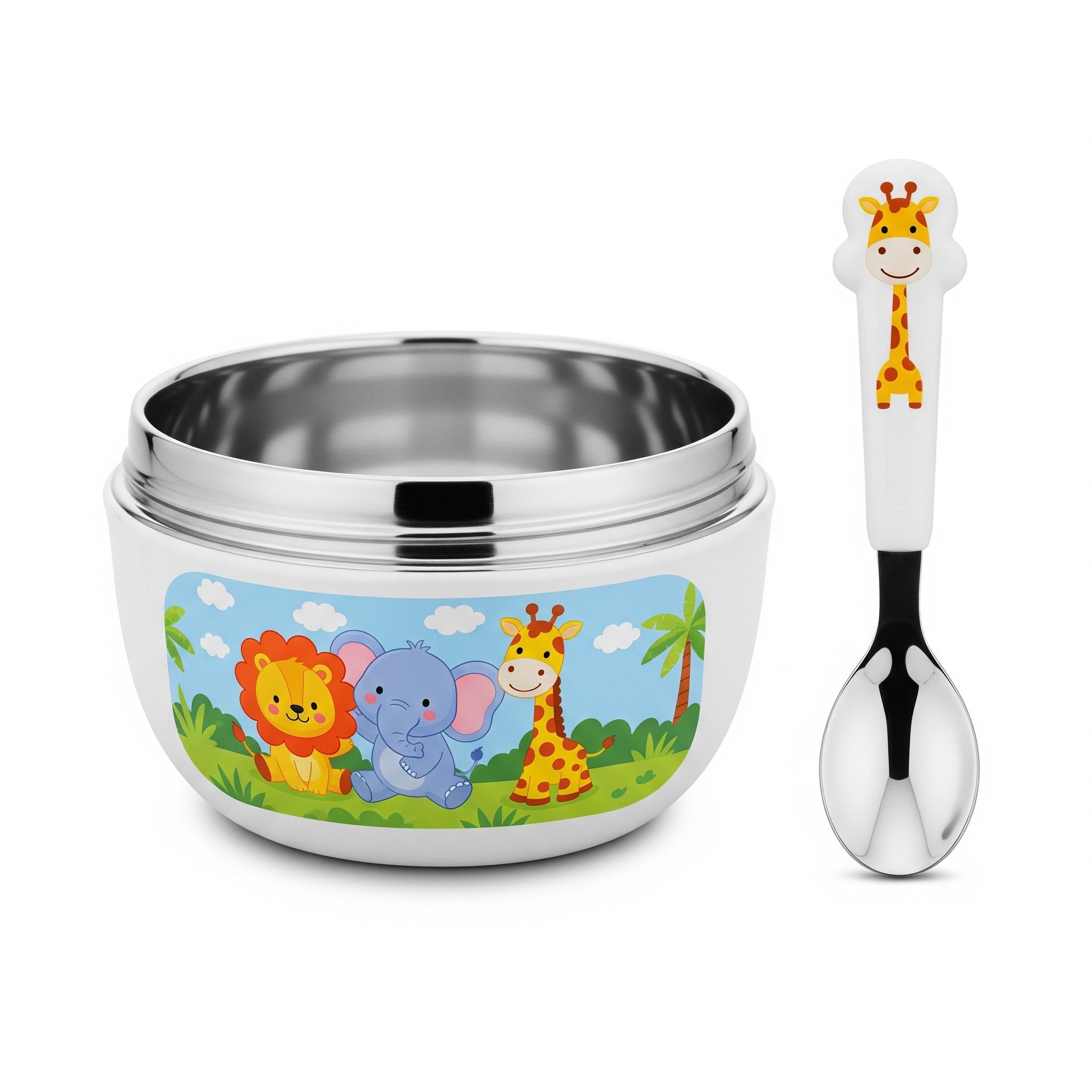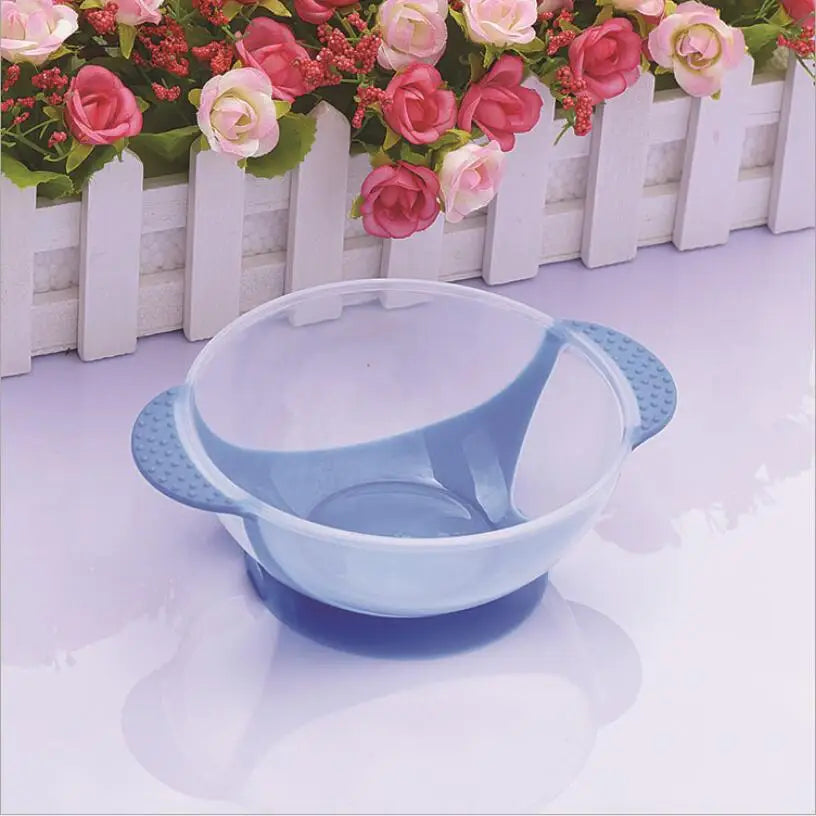
How to Clean and Maintain Baby Tableware
Share
Key Takeaways
- Use mild, baby-safe dish soap for daily cleaning of baby tableware
- Sanitize regularly using boiling water, steam, or baby-safe sanitizing solutions
- Store tableware in clean, dry containers with good ventilation
- Different materials (silicone, stainless steel) require specific care approaches
- Inspect regularly for cracks, wear, or damage and replace as needed
- Suction tableware requires special attention to the suction base
Introduction to Baby Tableware Care
Keeping your baby's feeding items clean and well-maintained is essential for their health and safety. Proper care for baby tableware ensures it remains hygienic, functional, and long-lasting. Whether you're using silicone suction bowls, stainless steel feeding sets, or training spoons, establishing good cleaning routines protects your little one from harmful bacteria while extending the life of your feeding essentials.
Baby tableware requires special attention because it comes into direct contact with your little one's food and mouth. Infants and young children are particularly vulnerable to germs due to their developing immune systems, which are still learning to fight off common bacteria and viruses. According to pediatric health experts, maintaining clean feeding equipment is one of the most effective ways to prevent foodborne illnesses in babies, whose digestive systems are especially sensitive during the first years of life. In this guide, we'll walk you through effective cleaning methods, maintenance tips, and storage solutions for different types of baby tableware to help you create safe, healthy mealtimes for your child throughout their developmental stages.
Daily Cleaning Essentials for Baby Tableware
Recommended Cleaning Supplies
For daily cleaning of your baby's tableware, you'll need a few essential supplies that are both effective and gentle. Using the right cleaning tools helps maintain the integrity of your baby feeding items while ensuring they're thoroughly cleaned without leaving harmful residues behind that could potentially affect your baby's health.
The most important supplies include:
- Mild, baby-safe dish soap without harsh chemicals or strong fragrances - look for products labeled "baby-safe" or "gentle" that are free from parabens, phthalates, and artificial dyes
- Soft bottle brushes and sponges designed for baby items with special shapes to reach all corners and crevices
- Clean microfiber cloths or towels for drying that won't leave lint or fibers behind
- Dedicated drying rack specifically for baby items to prevent cross-contamination from other kitchen items
- Silicone brush cleaners that can withstand high temperatures for sanitizing
Avoid harsh chemicals, strong detergents, and abrasive scrubbers that can damage tableware surfaces and potentially leave harmful residues that your baby might ingest. Pediatricians recommend avoiding antibacterial soaps for baby items, as they often contain triclosan and other chemicals that aren't necessary for proper cleaning and may pose health concerns with repeated exposure.
Step-by-Step Daily Cleaning Process
Following a consistent cleaning routine helps ensure your baby's tableware remains safe and hygienic throughout multiple daily feedings. Establishing these habits early will make the process more efficient and help guarantee your baby's feeding equipment is always ready for use. Here's a simple step-by-step process for daily cleaning that pediatric feeding specialists recommend:
1. Rinse immediately after use: Remove food residue by rinsing with warm water as soon as possible after feeding. The sooner you rinse, the easier it will be to clean thoroughly. Food particles that dry and harden can be much more difficult to remove completely and may require more aggressive cleaning methods that could wear down materials faster.
2. Wash thoroughly: Clean each item with mild dish soap and warm water, paying special attention to crevices, ridges, and hard-to-reach areas where food particles might hide. For items like our baby silicone spoons, be sure to clean around the handle connection points where food can accumulate unnoticed. Use a soft brush designed for baby items to gently scrub all surfaces, including textured areas designed to help babies grip their utensils.
3. Rinse completely: Ensure all soap residue is rinsed away as it can cause stomach upset if ingested. Use warm running water and rinse multiple times if needed. Research published in the Journal of Pediatric Gastroenterology and Nutrition suggests that soap residue can potentially irritate a baby's sensitive digestive system, making thorough rinsing especially important.
4. Air dry properly: Place items on a clean drying rack or towel, ensuring good air circulation. Proper drying prevents mold and bacterial growth. Never store items while they're still damp as moisture creates an ideal environment for microorganisms to multiply. Position items so that water can drain completely, especially from crevices and hollow parts.
For suction tableware, make sure to clean underneath the suction base thoroughly, as food particles can get trapped there and affect the suction functionality. The hidden underside of suction bases can harbor bacteria if not properly cleaned, so separating removable suction bases when possible will ensure a more thorough cleaning.
Sanitizing Baby Tableware
When to Sanitize
While daily cleaning is sufficient for regular use, sanitizing provides an extra level of protection by reducing germs to levels considered safe by public health standards. Sanitizing is particularly important in certain situations where your baby might be more vulnerable to infection or when tableware might have been exposed to more harmful microorganisms than usual. Child health experts from the American Academy of Pediatrics recommend more frequent sanitizing during your baby's first six months, when their immune system is still developing its full capabilities.
- For new tableware before first use to remove any manufacturing residues or packaging contaminants
- After your baby has been sick to prevent reinfection or spreading illness to other family members
- For younger babies with developing immune systems (under 6 months) who are more susceptible to infections
- Weekly as a general practice for all baby feeding items to maintain optimal hygiene
- After the items have been dropped on the floor or touched by pets
- When returning from travel where cleaning conditions might have been less than ideal
Effective Sanitizing Methods
There are several effective methods for sanitizing baby tableware, depending on the materials and your personal preference. Each method has specific advantages and considerations, particularly when dealing with different materials like silicone, plastic, or stainless steel. The Centers for Disease Control and Prevention (CDC) confirms that proper sanitizing can significantly reduce the risk of foodborne illness in infants.
Boiling Water Method
1. Place thoroughly cleaned items in a pot of boiling water, ensuring there are no soap residues left
2. Ensure all parts are fully submerged beneath the water's surface to guarantee complete sanitization
3. Boil for 5 minutes (2-3 minutes for silicone items to prevent potential damage from prolonged heat exposure)
4. Remove with clean tongs and allow to air dry completely on a clean, dedicated drying rack
This method works well for most silicone and plastic items, including our Bubira silicone baby tableware set. The boiling water reaches a temperature of 212°F (100°C), which is sufficient to kill most harmful bacteria and viruses that could potentially cause illness in infants. This method is particularly recommended by pediatricians for babies under 3 months or those with compromised immune systems.
Steam Sterilizing
1. Follow the manufacturer's instructions for your steam sterilizer, whether electric, microwave, or standalone
2. Ensure all items are clean before sterilizing as steam cannot penetrate food residue effectively
3. Place items with openings facing down to ensure steam reaches all surfaces and can penetrate internal areas
4. Allow items to cool and dry before storage to prevent condensation that could promote bacterial growth
Steam sterilizing is particularly effective for bottle nipples and small parts that might be difficult to clean thoroughly. The high-temperature steam can reach into small crevices and openings that might be missed during manual cleaning. Modern steam sterilizers maintain temperatures around 230°F (110°C), which is highly effective at eliminating pathogens without the need for chemicals.
Sanitizing Solutions
If using sanitizing solutions, choose products specifically designed for baby items and follow the manufacturer's instructions carefully. According to the CDC, proper sanitizing kills germs that might remain after cleaning, providing an extra layer of protection for your baby. When using chemical sanitizers, always ensure they're food-safe and rinse thoroughly afterward if recommended by the manufacturer.
For a natural sanitizing solution, you can create a mixture of one tablespoon of white vinegar per quart of water. This solution is effective against many common bacteria and doesn't leave harmful chemical residues. However, it's important to note that while vinegar solutions are good for general sanitizing, they may not be as effective against all pathogens as heat-based methods.
Material-Specific Care Instructions
Different materials require specific care approaches to maintain their quality and safety. Understanding how to properly care for each type of material will help extend the life of your baby's tableware while ensuring it remains safe and functional throughout your child's feeding journey. Materials respond differently to cleaning agents, temperature changes, and physical wear, making material-specific care essential for optimal maintenance.
Silicone Tableware Care
Our silicone baby tableware is durable and easy to clean, but requires some specific care to keep it in optimal condition for the long term. Silicone is naturally resistant to bacteria and doesn't harbor microorganisms like some other materials might, but proper care enhances these beneficial properties:
Silicone tableware is dishwasher safe, but hand washing is often better for long-lasting products. To remove food odors that silicone sometimes absorbs, try soaking it in a solution of warm water and baking soda (1 tablespoon per cup of water) for 30 minutes. This works great for getting rid of strong smells from foods like garlic or fish that might have been in baby purees.
For stains, lemon juice or white vinegar can help without damaging the silicone. You can also make a paste with baking soda and water for stubborn discoloration. While silicone can handle heat up to about 450°F, try not to expose it to direct heat sources for too long. Also, keep silicone items out of direct sunlight when possible, as UV rays can eventually make the material less flexible.
As discussed in our article on silicone safety, high-quality food-grade silicone is non-toxic and resistant to bacteria, making it an excellent choice for baby tableware. It doesn't harbor bacteria or develop cracks where germs can hide, unlike some plastic alternatives that may develop micro-scratches over time. Medical-grade silicone, which is used in many premium baby products, undergoes rigorous testing to ensure it's free from BPA, PVC, phthalates, and other potentially harmful chemicals.
Stainless Steel Tableware Care
For our stainless steel tableware, which offers excellent durability and safety for babies at all stages:
While stainless steel items can go in the dishwasher, washing them by hand helps keep them looking nicer longer. Harsh dishwasher detergents can sometimes dull the finish over time. Use soft sponges instead of rough scrubbers to avoid scratching the surface, since scratches can trap bacteria.
To prevent water spots, dry stainless steel items right after washing. If you notice spots, a mix of equal parts white vinegar and water can help remove them. For discoloration, try a paste of baking soda and water, rubbing gently in the direction of the steel grain. Try not to leave salty foods in stainless steel containers for too long, as salt can damage the surface.
Stainless steel is particularly valuable for first stage feeding as it's durable and doesn't absorb flavors or odors, maintaining a clean taste for your baby's food. Food-grade stainless steel (typically 18/8 or 18/10 grade) is also naturally resistant to bacterial growth and doesn't leach chemicals into food, making it one of the safest materials for baby feeding equipment according to environmental health researchers.
Special Care for Suction Tableware
Our suction tableware requires special attention to maintain its suction functionality and prevent food buildup in hard-to-reach areas. The suction mechanism is a crucial feature that helps prevent spills and messes during mealtimes, but it also creates additional cleaning challenges that require specific maintenance approaches.
Cleaning Suction Bases
1. Separate if possible: If the suction base is removable, separate it for thorough cleaning of both parts. This allows you to reach all surfaces that might otherwise remain inaccessible. Some suction bases twist off, while others may pull straight away from the bowl or plate.
2. Clean underneath: Pay special attention to the underside where food and moisture can accumulate unnoticed. Use a small, soft brush to clean around the edges and within any grooves of the suction mechanism. These hidden areas can harbor bacteria if not properly cleaned, potentially affecting both hygiene and suction performance.
3. Dry completely: Ensure the suction base is completely dry before reattaching or using, as moisture can reduce suction effectiveness and potentially promote mold growth in the enclosed space between the base and the feeding surface. Allow to air dry completely, or use a clean, lint-free cloth to dry thoroughly.
4. Check for food particles: Remove any trapped food particles that might affect suction or harbor bacteria, especially in the rim where the suction base meets the bowl or plate. Even tiny food particles can create enough space for air to enter, reducing the vacuum seal that creates the suction effect.
Maintaining Suction Functionality
To keep the suction mechanism working properly throughout your baby's feeding journey:
- Keep suction surface clean: Wipe the suction surface with a damp cloth before each use to remove any dust or debris that could interfere with proper adhesion. Even invisible particles can prevent a proper seal from forming.
- Apply to clean surfaces: Ensure high chair trays or tables are clean and smooth before attaching suction tableware. Textured, porous, or dirty surfaces will significantly reduce suction effectiveness. The suction works best on non-porous surfaces like glass, sealed wood, or smooth plastic.
- Avoid oils and residues: Oils or soap residues can reduce suction effectiveness by preventing the creation of a proper vacuum seal. Ensure both the suction base and the surface it's being applied to are free from oils and completely rinsed of soap.
- Regular inspection: Check for wear or damage to the suction mechanism, including cracks, tears, or deformation that might affect performance. The flexible edges of the suction base are particularly vulnerable to damage and should be inspected regularly.
- Proper storage: Store suction tableware with the suction base protected to prevent dust accumulation or damage to the flexible edges that create the seal.
Our Ultimate Suction Cup Baby Bowl Set features an enhanced suction base designed to maintain strong adherence even with regular use, but proper cleaning is essential to preserve this functionality. The specialized silicone formulation used in our suction bases is engineered to create a stronger vacuum seal while remaining easy to remove when needed by parents.
Proper Storage of Baby Tableware
Proper storage is essential for maintaining the cleanliness and extending the lifespan of your baby's tableware. Good storage practices prevent contamination and make mealtime preparation more efficient, reducing stress during busy feeding times. Storage solutions should evolve as your collection grows and your baby's needs change throughout their feeding development.
Storage Guidelines
As detailed in our guide on storing baby utensils, we recommend these evidence-based practices:
- Ensure complete dryness: Store only completely dry items to prevent mold and bacteria growth. Moisture trapped in storage containers creates an ideal environment for microorganisms to multiply. Allow items to air dry completely before storing, or dry thoroughly with a clean, lint-free cloth if immediate storage is necessary.
- Use dedicated containers: Store baby tableware separately from other kitchen items to prevent cross-contamination from cooking utensils that might have been exposed to raw meats or other potential contaminants. Dedicated containers also make it easier to quickly find what you need during busy mealtimes.
- Consider ventilated containers: Allow for air circulation to prevent moisture buildup that could lead to mold growth, especially in humid environments. Containers with small ventilation holes or mesh sections are ideal for maintaining airflow while keeping dust and contaminants out.
- Organize by type: Group similar items together for easy access during busy feeding times. Consider separating items by feeding stage (puree spoons, training utensils, self-feeding tools) or by meal type (breakfast items, snack containers, dinner plates) depending on your typical routine.
- Avoid overcrowding: Prevent scratching or damage by avoiding overcrowded storage. Silicone items in particular can become misshapen if stored under pressure for extended periods. Allow enough space for items to be removed without disturbing everything else in the container.
Creating an Efficient Storage System
An organized storage system makes mealtime preparation easier and helps maintain the condition of your baby tableware by reducing handling damage and exposure to contaminants:
Keep baby tableware in a specific drawer or cabinet that's easy to reach, ideally at a height where you can grab things while still holding your baby. Child development experts suggest keeping items you use often between waist and shoulder height to make feeding time easier.
Use drawer dividers to separate different types of tableware so they don't get tangled or damaged. You can adjust these dividers as your collection changes or as your baby grows and needs different feeding tools.
Consider storing bottles and cups standing up to save space and prevent water from collecting at the bottom. This vertical storage also lets you see everything at once, so you don't waste time searching for what you need.
Labels are really helpful, especially when other people help feed your baby. Clear labels show everyone where to find and return items, keeping everything organized. Picture labels work well for caregivers who might speak different languages.
A well-organized storage system not only keeps tableware clean but also makes mealtime preparation more efficient, which is especially helpful during busy days with a hungry baby. Research in family resource management suggests that efficient organization systems can save parents up to 30 minutes daily in meal preparation and cleanup time.
Dealing with Common Tableware Issues
Removing Stubborn Stains
Food stains, especially from carrots, tomatoes, berries, and other intensely colored foods, can be challenging to remove from baby tableware. These pigmented foods contain natural dyes that can penetrate porous materials and leave behind stubborn stains that regular washing might not eliminate. For our silicone spoons and other tableware, try these effective stain removal methods:
For tough stains, try making a paste with baking soda and water (3 parts baking soda to 1 part water). Spread this on the stained areas and let it sit for about 30 minutes before washing it off. The baking soda gently scrubs away stains without scratching the surface, and its alkaline properties help break down food acids that cause discoloration.
Sunlight can also help fade stains naturally. After cleaning your baby's plastic or silicone items, put them in direct sunlight for 3-4 hours, turning them occasionally for even exposure. The sun's UV rays break down the color molecules in many food stains, similar to how it naturally bleaches clothes.
For lighter stains, try rubbing them with lemon juice. The natural bleaching properties and acid in lemon juice help break down food residues. This works especially well on tomato-based stains and can help restore silicone items to their original color.
Always test these methods on a small, hidden area first to make sure they don't damage the material. Different approaches work better for different types of stains and materials, so you might need to try a few methods to find what works best for your situation.
Addressing Odors
For our silicone cups and other tableware that may retain odors from strong-smelling foods or after being stored improperly:
To remove stubborn smells, soak items in a solution of 2 tablespoons baking soda per quart of warm water for at least 4 hours or overnight for really persistent odors. Baking soda actually absorbs and neutralizes odors instead of just covering them up with another smell.
A vinegar rinse can also help. Mix equal parts white vinegar and water, and rinse your baby's tableware with this solution. This works well for neutralizing odors from dairy products and some vegetables. The acid in vinegar changes the pH of the surface, which helps eliminate odor-causing bacteria and neutralize food smells.
For a fresher approach, try soaking items in warm water with fresh lemon slices for 1-2 hours. The natural oils in lemon peel contain a substance called limonene, which helps dissolve oils that might be trapping odors while leaving behind a clean citrus scent.
For persistent odors in silicone items, you can also try boiling them for 5-10 minutes in plain water, which helps release trapped odors from the material. The heat causes the silicone to expand slightly, releasing trapped odor molecules that might be embedded in the material's tiny pores. This method works particularly well for milk odors that can become sour if not properly removed.
When to Replace Baby Tableware
Even with proper care, baby tableware will eventually need replacement. Knowing when to retire items ensures your baby's feeding equipment remains safe and functional. Pediatric feeding specialists recommend regular inspection of all baby feeding items to identify potential safety issues before they become problematic.
Replace items with cracks or chips, as these can hide bacteria and potentially hurt your baby's sensitive mouth. Bacteria can hide in tiny cracks that are hard to clean properly, which could cause repeated illness.
Watch for worn-down utensil tips that may become sharp or rough, possibly causing discomfort or small injuries to your baby's gums and developing palate. The protective coating on some metal utensils can also wear away over time.
Pay attention to significant fading or discoloration, which might indicate the material is breaking down and could potentially release chemicals. While some discoloration is just cosmetic, severe or sudden color changes might mean the material is degrading.
If suction bases no longer stick properly despite thorough cleaning, the material may have lost its stretchiness or become permanently misshapen. When suction doesn't work well anymore, these specialized items can't prevent spills like they're supposed to.
Consider our stylish tableware options when it's time for replacements, and don't forget to check our high chair accessories to complete your feeding setup. Regular replacement of worn items is a small investment in your baby's health and safety that pays dividends in reduced risk of foodborne illness and feeding injuries.
Travel and On-the-Go Maintenance
Maintaining cleanliness while traveling requires some extra planning and specialized approaches. Having a portable cleaning kit ensures you can keep your baby's tableware clean no matter where you are, from restaurants to relatives' homes to hotel rooms. Pediatric travel experts recommend preparing a dedicated travel cleaning kit that can be kept in your diaper bag or travel gear.
Quick Cleaning on the Go
Carry baby-safe cleaning wipes designed specifically for tableware when you're out and about. These provide a convenient no-rinse option when you don't have access to proper washing facilities. Look for wipes that are food-safe and free from harsh chemicals, alcohol, or strong fragrances that might leave residues.
Pack compact brushes for cleaning while away from home so you can reach all surfaces of bottles and cups. Some travel brushes come with protective cases to keep them clean between uses or fold down for easier packing.
Bring small containers of baby-safe dish soap so you don't have to use whatever soap might be available, which could contain harsh chemicals or fragrances. Concentrated formulas let you pack less while still having enough for multiple cleanings.
When you don't have access to thorough cleaning facilities, focus on removing food residue immediately and doing a more thorough clean when you return home. The American Academy of Pediatrics recommends at least a good rinse after each use when traveling, followed by complete cleaning and sanitizing when you get home.
Travel Storage Solutions
Use ventilated travel cases that allow air circulation to prevent moisture buildup while protecting items from contamination in transit. These specialized cases often have antimicrobial linings to further reduce the risk of bacterial growth.
For our silicone bottles and utensils, silicone pouches provide flexible, waterproof storage that can be easily cleaned and sanitized themselves. The non-porous nature of silicone means these pouches won't harbor bacteria like fabric alternatives might.
Our glass baby bottles need protective cases to prevent breakage during transport. Padded cases designed specifically for glass bottles provide impact protection while still allowing you to see what's inside for easy selection.
Use designated pouches for used items that need cleaning to prevent contamination of clean items. Waterproof, machine-washable wet bags designed for cloth diapers work really well for this purpose, containing both mess and odor until proper cleaning is possible.
When traveling, it's also helpful to pack extra tableware so you always have clean items available while others are waiting to be properly cleaned. Travel feeding experts recommend packing at least one extra of each essential feeding item to account for unexpected messes or cleaning delays while away from home.
Seasonal Maintenance and Deep Cleaning
In addition to daily cleaning, perform these maintenance tasks periodically to keep your baby tableware in optimal condition and ensure it's thoroughly sanitized. Establishing a regular schedule for deeper cleaning prevents the gradual buildup of residues that might not be visible but could affect both the safety and functionality of your baby's feeding equipment.
Quarterly Deep Cleaning
Every few months, sanitize all items, even those used less frequently, to eliminate any bacteria that might have accumulated during storage. This includes seasonal items, travel feeding equipment, and backup pieces that aren't in regular rotation.
Check all items for wear, cracks, or other issues that might have developed gradually and gone unnoticed during daily use. Pay special attention to connection points, hinges, and areas that undergo stress during use.
Remove mineral deposits from water bottles with a vinegar solution (equal parts white vinegar and water) by soaking for 30-60 minutes. Mineral buildup can affect how valves and straws in sippy cups work and can potentially harbor bacteria in the rough surface they create.
Clean the containers where you store tableware, as these can collect dust and bacteria over time even when the tableware itself is clean. Take everything out, clean thoroughly with soap and water, and let dry completely before putting items back.
A deep cleaning session every few months helps maintain the highest standards of cleanliness and gives you a chance to thoroughly inspect all your baby feeding items. This quarterly maintenance is particularly important during seasonal transitions when feeding habits might change (more outdoor meals in summer, more soups and warm foods in winter).
Seasonal Rotation
As your baby grows, their tableware needs will change significantly. A 6-month-old needs different feeding tools than a 15-month-old learning self-feeding skills. Regularly assess whether your current collection matches your baby's developmental stage.
Store seasonal items (like holiday-themed tableware) when not in use to prevent unnecessary wear and free up storage space for currently needed items. Proper storage of seasonal items in clean, dry containers ensures they'll be ready for use when needed.
Remove items that are no longer age-appropriate or have been outgrown. Consider donating gently used items that are still in good condition to local family resource centers or passing them along to friends with younger children.
Regular assessment of your baby tableware collection ensures you always have the right tools for your child's current feeding stage, keeping mealtimes safe and developmentally appropriate.
